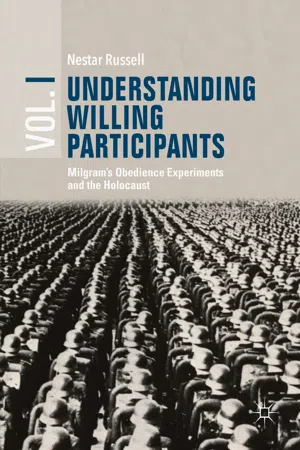When in 1945 the advancing Soviet Army put a stop to the Holocaust, about six million European Jews were already dead. Jews, of course, were not the only civilian victims of Nazi violence —the gay community, people with physical/intellectual disabilities, Roma and Sinti Gypsies , communists , Afro-Germans , Jehovah’s Witnesses, Slovenes, Poles , and Russians also suffered persecution. Rummel puts the total number of civilians killed by the Nazis at 16,315,000. 1 Unlike these other groups, however, the Nazis aimed to kill all Jews and so, as Marrus argues, “In this respect, the fate of the Jews was unique.” 2 It is for this reason that when delving into the perpetration of Nazi violence, this book focuses mostly—although certainly not exclusively—on the victimization of European Jews.
But whether victims were Jewish or otherwise,
Clendinnen has asked that unsettling question pondered by many a student of the Holocaust:
In the case of Nazi ‘desk murderers ’ it may be possible to estimate how far ideology and how far ambition (not to mention lack of imagination) worked to sustain their enthusiasm for murder […] With the ‘hands-on’ killers the problem is at once more visceral, and more opaque. We know they killed, and killed on a massive scale. The question is: how could they do it? 3
With reference to the scholarly discipline that dominants Holocaust
studies ,
Headland more specifically places his finger on why he thinks so little progress has been made on this question:
Whatever necessary detachment historians may bring to their research, the gnawing horror of the firing squads and the gas chambers intrudes. There is a dimension of understanding here that eludes us. 4
The historians, it seems, are as baffled as the rest of us. Perhaps the killings were organized and manned by a carefully selected concentration of the worst elements of German society: the sadists, psychopaths, and criminal opportunists? But this was not the case. Raul Hilberg has found that the vast majority of German perpetrators were remarkably
ordinary.The bureaucrats who were drawn into the destruction process were not different in their moral makeup from the rest of the population. The German perpetrator was not a special kind of German. […] Even the killing units and the killing centers did not obtain professional killers. 5
The Holocaust was such a massive logistical undertaking that the Nazi regime did not have the luxury of time or resources to recruit professional or hardened killers to do their dirty work. Instead, they recruited from the broadest of social circles. For example, according to Daniel Goldhagen, the ordinary men of
Reserve Police Battalion 101 differed in no significant way from other
German men of a similar age. Most were not even members of the Nazi party. Three-quarters of them had no affiliation with any of the major Nazi institutions, and some had even harbored hostility toward the Nazi party. The majority came from
Hamburg , a city that did not generally support the Nazi regime. They were for the most part older family men who had lived under very different political systems and ideologies. These men “were not wide-eyed youngsters ready to believe whatever they were told.” Also, there was no effort to ideologically reshape this unlikely group of would-be executioners for their future tasks.
6 As Christopher Browning, who researched the same battalion, concludes, “The men would not seem to have been a very promising group”
for Hitler to rely upon to bring about his “racial utopia free of Jews.”
7 Yet, they participated in many killing operations and executed thousands of Jews. There is even evidence they killed babies.
8 But these unlikely executioners did more than kill. Goldhagen shows that they often volunteered to pursue their Jewish victims with cruel determination. For example, on 26 May 1943, they deported Jews from the Polish township of
Miȩdzyrzec to
Treblinka . Goldhagen writes,
Survivors are adamant that the Germans [in Reserve Police Battalion 101 ] were indeed incredibly brutal, that their cruelty that day was wanton, at times turning into sadistic sport. At the marketplace, the Jews…were “mocked” (khoyzek gemacht) and “kicked,” and some of the Germans organized “a game” (shpil) of “tossing apples and whoever was struck by the apple was then killed.” This sport was continued at the railway station, this time with empty liquor bottles. “Bottles were tossed over Jewish heads and whoever was struck by a bottle was dragged out of the crowd and beaten murderously amid roaring laughter. Then some of those who were thus mangled [tseharget] where shot.” […] these ordinary Germans appeared…not as reluctant killers dragged to their task against their inner opposition to the genocide, but as “two-legged beasts” filled with “bloodthirstiness.” 9
The few survivors of this deportation were not the only ones who recalled acts of sadism. One member of the battalion later remembered that their leader, Major Trapp , had even rebuked his men for their cruelty . Trapp told his men that they “had the task to shoot the Jews, but not to beat and torture them…” 10 From evidence such as this, Goldhagen concludes that a unique strain of exterminationist , antisemitic hatred caused ordinary Germans to willingly and directly participate in the Holocaust.
Goldhagen’s book was enthusiastically received by the reading public—even in Germany. Perhaps its appeal lies in trying to imagine how hatred could not have been a central feature of the Holocaust. Why, after all, would ordinary Germans like those in Reserve Police Battalion 101 repeatedly volunteer to do cruel and brutal things to people they did not hate? However, it is at this point in the Holocaust literature where the historiography becomes complicated, perhaps even bewildering. That is, although the antisemitism of Germany’s many Ukrainian, Latvian, and Lithuanian helpers is undisputed, 11 the Israeli historian Yehuda Bauer argues that, excepting a few hundred hardcore true believers like Hitl...
